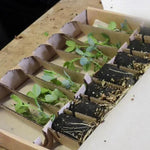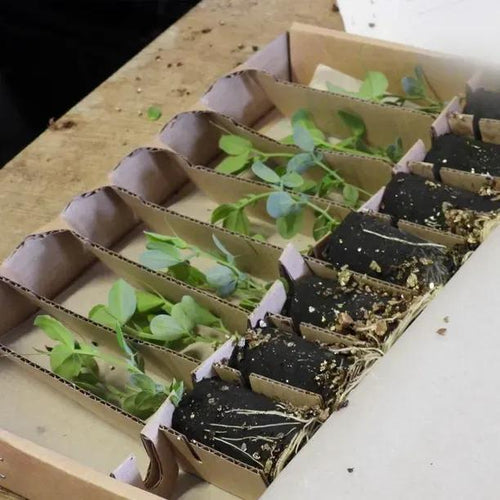Albutt Blue Sweet Pea Plants
A semi-grandiflora, Albutt Blue combines the advantages of the Spencer sweet pea varieties having long, straight stems for cutting and bigger, often wavy, flowers of which there may be many per stem, along with the Grandiflora strength of tremendous vigour and a fantastic fragrance. Albutt Blue is a picotee sweet pea which means that it has a rim of dark colour (in this case navy blue) elegantly outlining the edge of its palest lavender-blue petals accentuating their natural wave. This neat conceit's very attractive. Albutt Blue is arguably the sweet pea with the most outstanding fragrance of all and grows to about 180 cm; - tall enough for most purposes. A great addition to our range of sweet peas.
Our Sweet Peas are delivered in purpose-designed, recycled cardboard packaging, and are ready to be planted out when you get them.
We generally send them out between March and May, but we will email you with the likely delivery timescale once you have placed your order.
Garden Design Ideas
The picotee rim invites you to grow other sweet peas with Albutt Blue to home in on its ambidextrous colouring. We think Lord Nelson will definitely pick Albutt Blue up by the bootstraps and both will benefit. Otherwise, have a look through the rest of our range of sweet peas for more inspiration. Don't just relegate your sweet peas to the cutting garden and especially not Albutt Blue because that smell is unforgettable. Albutt Blue isn't too big and as a grandiflora its flowers emerge from top to toe. Consequently, Albutt Blue would look fantastic planted in a pot - put the support in first! - and grown on a terrace so that you can enjoy all of that scent. The only caveat is that you have to keep watering.....but it's so worth it in this case. Otherwise, sweet peas can happily intertwine with other climbers up a pergola or some such and why not Albutt Blue using your wisteria as a frame? Never forget that being leguminous they actually extract nitrogen from the air and fix it in the soil ready for your other plants to use so they're an enormously positive addition.
Features
- Colour: palest lavender blue/white and navy edge
- Stem: long, straight, not thick
- Height: 1.8 m
- Type: Semi-Grandiflora
- Scent: outstanding - the best
- Flowering: May to August
- Planting Months: March-June
History & Trivia
Albutt Blue isn't a pun on the flower being mainly not blue but it was actually raised by a Mr Harvey Albutt. Eagle Nurseries had the good sense to sell it commercially in 1999 and it has remained top of the sweet pea pops since then.








 Secure, One-Tap Checkout
Secure, One-Tap Checkout
 Hand Picked, Delivered to Your Door!
Hand Picked, Delivered to Your Door! 1 Year Bareroot Guarantee
1 Year Bareroot Guarantee




